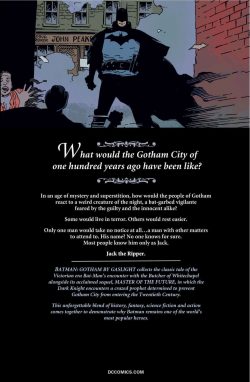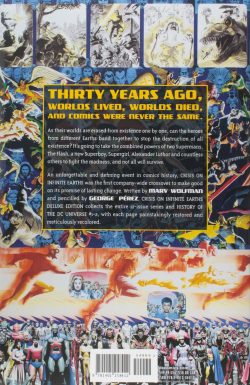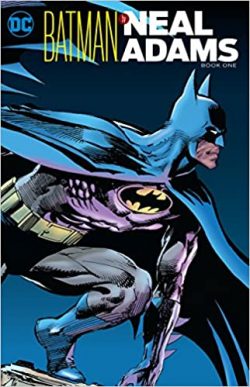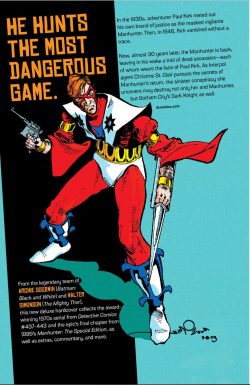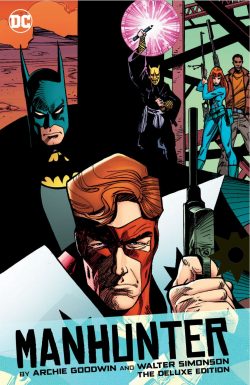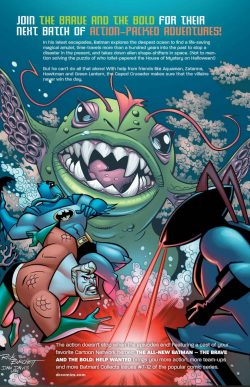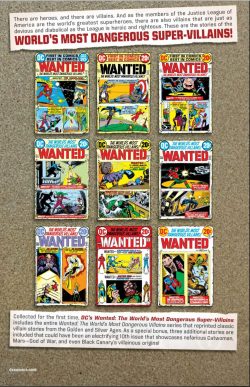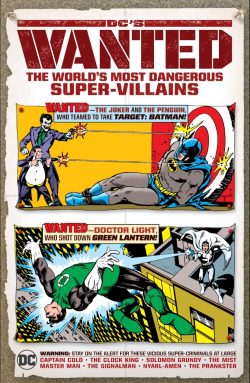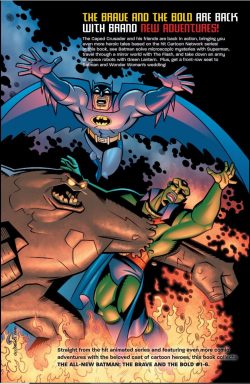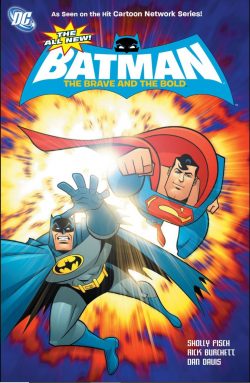
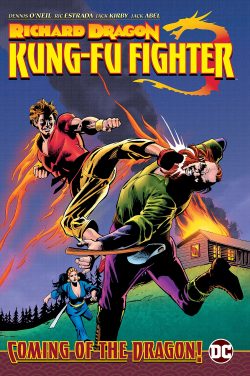
By Dennis J. O’Neil, David Anthony Kraft, Bob Haney, Mike W. Barr, Leopoldo Durañona, Jim Starlin, Alan Weiss, Jack Kirby, Ric Estrada, Jim Aparo, Alex Saviuk Wally Wood, Jack Abel, Al Milgrom, D. Bruce Berry, Vince Colletta & various (DC Comics)
ISBN: 978-1-7795-0810-2 (HC/Digital edition)
The mysterious martial arts of the Orient have always fascinated western readers and writers. Adventurers like Batman, Doc Savage, The Spider and The Shadow drew much of their history and arsenal from the arcane Orient and even intellectual champion Sherlock Holmes occasionally employed the scientific combat system of “Baritsu†– actually a mixed martial art called Bartitsu which developed between 1898-1902. Moreover, every secret agent worth their salt was au fait with assorted “chop sockey†techniques: generally disparaging them while delivering a signature blow…
Putting aside references in assorted newspaper strips, the first specialist martial arts comic book star was Judo Joe: a young American raised in Japan who used his training for the benefit of all. Three issues were released between August and December 1953: the work of Dr Barney Cosneck and illustrator Paul W. Stoddard, setting the tone of the genre as well devising as an enduring feature illustrated lessons on specific moves and techniques. Kids! DO try this at home (but not on the cat, that why we let you have little brothers…)!
Comics in the 1960s were sprinkled with judo and karate users, and by far the most accurate forms were employed by Charlton Comics champions Sarge Steel (#1 December 1964, by Pat Masulli & Dick Giordano) and WWII costumed combatant Judomaster (first seen in Special War Series #4, November 1965): both benefitting from the Kung Fu knowledge and artistic skills of Frank McLaughlin – an actual judoka who had studied martial arts for years.
Gold Key simply exploited licensing power. Television’s The Green Hornet ran 26 episodes from September 1966 to March 1967 and their comics adaptation (3 issues from February to August 1967) played up the combat skills of the mystery man’s chauffeur/partner Kato. You’ll recall I’m sure, that he was played by young Bruce Lee who was in very large part responsible for the popularisation of martial arts in the west… especially after graduating to film roles.
When the big boom began in the early 1970s, Charlton were again quick off the mark: launching their own knock-off of TV series Kung Fu. Running 18 issues, Yang (by Joe Gill & Warren Sattler) launched with a November 1973 cover-date, recounting the life of a Chinese wanderer in the 1870s wild west. It spawned sequel House of Yang (#1-6 July 1975-June 1976) by Korean comics creator Sanho Kim which remains a visual highpoint to this day… if you can find it.
Marvel really reaped the benefits of the zeitgeist with the launch of Shang Chi, Master of Kung Fu in Special Marvel Edition #15 (cover-dated December 1973) and a flood of follow-ups including Iron Fist, Sons of the Tiger, Daughters of the Dragon and White Tiger.
As ever – and despite teenager Jim Shooter introducing Karate Kid to the Legion of Super-Heroes in 1966 (Adventure Comics #346, July) – ever-cautious DC were late to the party, even though one of their key writers was also the co-author of a Kung Fu novel…
…And Karate Kid? As the martial arts boom was subsiding, DC awarded him his own solo series, set primarily in the 20th century: 15 bi-monthly issues running from March/April 1976 to July/August 1978. He travelled through time and across realities, but never met the stars of this particular show…
The Seventies began with a downturn in superhero sales and a resurgence of traditional genre comic tales. A few years in, a new genre emerged: one blending eastern philosophy and personal combat systems with a real-world growth in organised crime – especially drug trafficking. Popular fiction responded with a wave of lone wolf vigilantes like Mack (The Executioner) Bolan and martial arts icon Remo Williams: The Destroyer, as hardboiled crime thrillers evolved and genres began to mash up…
Riding his own wave of comic success and celebrity from Batman, Justice League of America, Wonder Woman, Green Lantern/Green Arrow and Superman, former journalist Dennis J. O’Neil teamed up with editorial cartoonist James R, Berry to write a prose thriller for this burgeoning market. Under the pen-name Jim Dennis, they detailed the life path of teenage thug Richard Drakunovski after finding friends and direction with a martial arts sensei. Kung Fu Master, Richard Dragon: Dragon’s Fists was released in 1974 and ultimately pitted the hero against evil industrialist Guano Cravat…
With a phenomenon unfolding around them, DC joined the parade of warriors by having O’Neil adapt the book, expanding the premise and adding significantly to their pantheon of stars in the process: not so much with the leading man but through his potential-packed supporting cast.
Spanning April/May 1975 to November 1981, this fast and furious compendium collects Richard Dragon: Kung Fu Fighter #1-18; a team-up from The Brave and the Bold #132, plus a closing note from DC Comics Presents #39. In keeping with the tone of the genre and time, these stories are tersely underwritten and potently action driven, but racial and gender issues are ubiquitous and expressed in the terms of the times…
Opening episode ‘Coming of a Dragon!’ is credited to Jim Dennis and illustrated by comics legend Leopoldo Durañona, revealing how a teenager’s attempt to burgle a dojo in Kyoto, Japan is foiled by the head teacher O-Sensei. The venerable ancient easily masters the violent thief and then invites to him to change his life path. Richard Dragon spends the next seven years mastering countless forms of Kung Fu, higher education and his own raging nature, forming a lifelong bond with his fellow student, black American Ben Turner and seeking to become a physically and ethically “Superior Manâ€â€¦
The idyllic period ends the day unctuous freelance spymaster Barney Ling turns up. He runs acronymic organisation G.O.O.D. and begs the legendary O-Sensei to aid him in stopping a world class human trafficker. Instead, the master sends his students against an army of brutes and monsters…
O’Neil, Jim Starlin, Alan Weiss & Al Milgrom tackled ‘A Dragon Fights Alone’ as, wounded but triumphant, the duo return to Japan only to be targeted by the hired thugs of a hidden enemy. The attack comes in the wake of a tearful graduation, as they seek to aid O-Sensei’s goddaughter Carolyn Woosan, and results in them all heading for San Francisco. There, mercenary The Swiss had orchestrated her uncle’s death whilst searching for a deadly secret. When the freshly-debarked adventurers investigate, Ben is shot and Carolyn taken…
It clearly took some time to assign an art-team as Jack Kirby & D. Bruce Berry limned third instalment as ‘Claws of the Dragon!’ as an enraged hero hunts The Swiss, and trounces an army of assassins, thanks in no small part to his secret weapon – a jade claw that allows him to focus all his knowledge and fury and become a beast of battle…
Crushed by continuing failure to save Carolyn, Dragon and Ben reluctantly accept help from Ling and G.O.O.D. Marshalling his resources and infiltrating a suspect dojo, Dragon accepts that there is ‘A Time to be a Whirlwind!’, and again overcomes all physical opposition, but once more fails Carolyn – this time, forever. This shattering clash signalled the start of artistic stability as Ric Estrada took over pencilling, augmented by master inker Wally Wood…
Sandra Woosan debuts in #5, a woman destined to be a major player in DC continuity. Cover-dated December 1975/January 1976, ‘The Arena of No Exit!’ introduced Lady Shiva, a conflict-addicted swordswoman seeking bloody redress for her murdered sister. She was working for grotesque super arms-dealer Guano Cravat (the secret mastermind behind The Swiss), but rejected her assignment to kill Dragon once she had fought him and realised that staying in his orbit would generate all the murderous duels her killer’s heart hungered for…
In later years she would evolve into the most dangerous assassin on Earth: a major opponent of Batman, Robin, assorted Batgirls, Black Canary, the Birds of Prey and many others.
After foiling Cravat’s scheme, Dragon and Shiva are rewarded by Ling with magnificent matched swords: katana crafted by an 18th century master smith. However, it’s just a ploy to sweeten them up. G.O.O.D. needs them to recover a “misplaced†nuke on a volcanic island: one ruled by a modern pirate with an obsessive fixation on fighting with swords. He calls himself Slash…
The spectacular conclusion of ‘Island of the Inferno’ leads to a confrontation with occasional Batman and Wonder Woman villain Doctor Moon who uses Cravat’s money to transform mere humans into surgically-augmented programmable super-warriors in #7’s ‘Command: Slay the Dragon!’ All this time, Ben has been healing and teaching at the dojo he runs with Dragon, but his life is about to change after becoming romantically entangled with promising student Janey Lewis. When she and other students are attacked by Moon’s thugs, Dragon and Shiva retaliate but are almost killed by Moon’s colossal cyborg Topper. Almost…
Another old foe resurfaces in #8, striking at his despised enemies by murdering more dojo students and rendering the hero temporarily sightless, facilitating his scheme to ‘Slay the Blind Dragon’…
Estrada inks his own pencils in #9 as Barney Ling returns, revealing that many recent dojo attacks are masking a hidden plot to assassinate Ben. The manipulative G.O.O.D. guy offers to reveal all, but only if all three kung fu fighters carry out a few errands for him…
Thus Turner, Shiva and Dragon depart for tropical San Lorenzo to stop a monster ravaging the tourist destination: a thieving mutated killer known as ‘The Preying Mantis’, after which Ben discovers he’s inherited millions in prime timberland and heads north, with his allies in tow.
The lumberjacks are certainly killers embezzling all the profits. They have already murdered Turner’s sister – leaving him the guardian of an unsuspected nephew also called Ben – and their leader Hatchett does everything possible to destroy the nosy snoopers in ‘The Human Inferno!’ (inked by Jack Abel). However, the assassination attempts only slow, but do not cease…
Cover-dated September 1976, #11 offers a change of pace and scripter as David Anthony Kraft joins Estrada & Abel in a byzantine futuristic spy conspiracy that begins ‘When Strikes the Samurai!’ After being targeted by a disappearing Japanese warrior, the trio are sent into Communist China to secure an object dubbed the Tiger Tally which in turn could unlock the secrets of bewildering Project Moon Age Daydream…
The mission results in a trail of dropped bodies before ‘A Dragon Defiant’ is subjected to a duplication device that results in him literally beating himself up before thwarting rival maniacs Telegram Sam and Madame Sun…
Back in the USA for #13, the drama increases with O’Neil & Estrada’s reunion, as Ben is poisoned and Dragon and Shiva carve their way through a murderous legion ‘To Catch an Assassin!’ and secure an antidote. When that proves fruitless, detective work leads them to The League of Assassins and a desperate quest for their chief deviser of toxins.
Viper makes his potions in the wilds of Mongolia – perilously close to the Soviet Russian border – and the countdown quest allows no time for restraint, which only allows Shiva opportunity to do the work she loves without being held back…
With Turner’s death imminent, we pause here for a diversionary team-up as The Brave and the Bold #132 (February 1977 by veteran writer Bob Haney & ultimate guest star artist Jim Aparo) enquires ‘Batman – Dragon Slayer??’
When Denny O’Neil succeeded Murray Boltinoff as B&B editor, it resulted in a rather forced tale of duelling fight stylists after a publicity-shy billionaire sought to repay an imagined debt to good Samaritan Dragon by leaving him a mysterious bequest…
In his own title, Dragon’s quest for a cure takes him back to China to find the O-Sensei’s. At that time, unknown to all, his former master was Dr. Moon’s prisoner, so Richard and Shiva’s mission generates massive mayhem and an inconclusive duel with ‘The Man Who Studied with Bruce Lee’: a gullible yet proficient martial arts purist who had learned all the celebrity’s lost secrets…
The clash might have been pointless, but the rescued O-Sensei cures Turner, who pursues his relationship with Janey to the point of asking her father for permission to wed. Tragically, at that moment in #15, ‘The Axeman’ attacks Shipyard Security Chief Luke Lewis and his adored daughter is fatally caught in the crossfire…
Crushed and broken inside, Ben hunts the killer with Dragon at his side, uncovering shocking betrayal that intensifies his fury into mania. Using all their resources, they follow to the top of the world in #16, where ‘The Doom Seer’ – outrageous and tyrannical madman Professor Ojo (later to be a Green Lantern nemesis) – pits them and Lady Shiva against outlandish martial arts skaters and an arsenal of scientific terrors before #17’s ‘The Final Victim’ provides a spectacular conclusion, but no resolution…
Richard Dragon: Kung Fu Fighter finished with #18, but ‘The Secret of the Bronze Tiger’ set up years more stories. Bereft, Turner had vanished, presumed killed battling Ojo, whilst Dragon sank into despair and dissolution. Finally, Shiva dragged him out to investigate a mysterious masked martial artist and illegal fight club. Dragon was stunned to discover Ben was the Tiger – who retained all his skills but was apparently a ruthless criminal with no memory…
This storyline was picked up and expanded upon in future Batman tales involving Ra’s Al Ghul‘s League of Assassins and sinister splinter group Demonfang – whose leader was an ancient killer called The Sensei – and result in Bronze Tiger becoming an integral part of the Suicide Squad of post-Crisis on Infinite Earths DC Universe. In that rebuilt continuity, Shiva and Dragon would become crucial to the development of The Question (Vic Sage) and other martial arts-based characters, emphasising the ripple-effect of “the Superior Man†on an entire heroic universe…
Here however, there’s an epilogue of sorts as DC Comics Presents #39 (November 1981, by Mike W. Barr, Alex Saviuk & Vince Colletta) reveals ‘Whatever Happened to Richard Dragon: Kung Fu Fighter?’ Having retreated to the peace of a Shaolin monastery, Dragon is called back to the outside world to save mind-controlled Bronze Tiger from the person who had truly been responsible for most of their perils and hardships all along…
With covers by Dick Giordano, Wiess, Milgrom, Estrada & Colletta, Jose Delbo, Ernie Chan, Aparo & Rich Buckler, and including Who’s Who character profiles of Dragon, Bronze Tiger and Lady Shiva, this compendium is very much of its time, but still offers universal thrills and spills whilst providing crucial context to all devotees of DC’s overarching multiversal continuity.
© 1975, 1976, 1977, 1981, 2021 DC Comics. All Rights Reserved.



